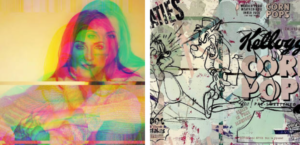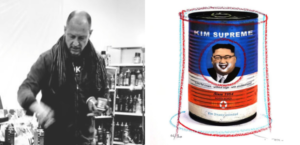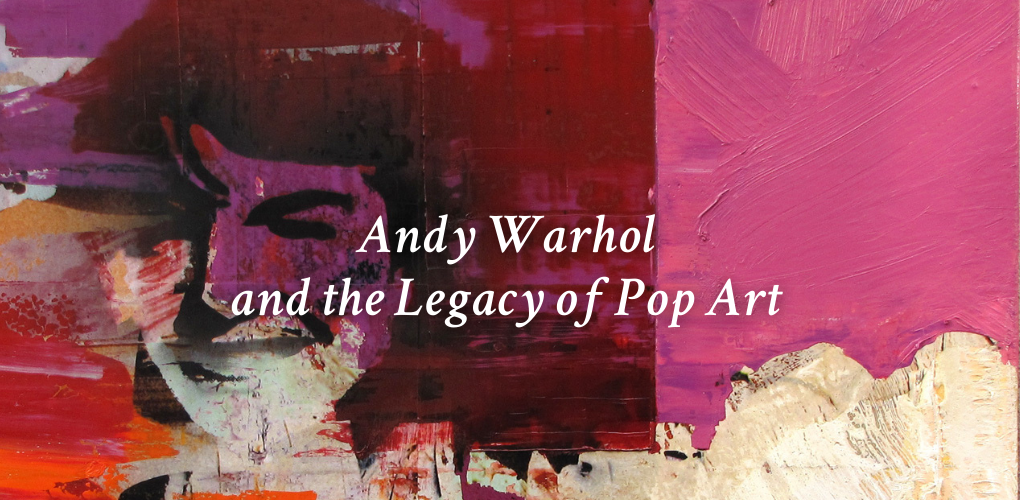Art History 101
Andy Warhol and the Legacy of Pop Art
American artist Andy Warhol is widely recognized by audiences and critics alike as the leading figure in the American Pop art movement. Fascinated by materialism and mass media, Warhol and his depictions of consumer goods and celebrities fundamentally altered the art world and its relationship to consumerism. From Campbell’s Soup Cans (1962) to The Marylin Diptych (1962), Warhol’s silk-screen prints, paintings, and even sculptures are icons that continue to resonate today.
Andy Warhol, born Andrew Warhola to Austro-Hungarian immigrants, was raised in Pittsburgh, Pennsylvania. Warhol’s interest in the arts and pop culture flourished during his childhood when, due to his infliction of the neurological disorder Sydenham’s chorea, he was occasionally bedridden and entertained himself with movies and radio programs. Warhol went on to study commercial art at Carnegie Mellon University, an education which steered him towards a career in advertising and illustration.
It was during this time that Warhol began experimenting with silk-screen printing, a technique which is now synonymous with his oeuvre. In the 1960s, he developed a unique, commercially informed style, exhibiting Campbell’s Soup Cans (1962) at the Ferus Gallery in Los Angeles. Many reacted to these mundane depictions of everyday objects with shock and condemnation. This was unsurprising considering the Abstract Expressionist movement that preceded Pop art in the United States, an art form whose philosophy was rooted in reflections of the artists’ pure, personal psyches.
Warhol was a visual pioneer in this manner, bringing our greater culture’s obsession with fame, wealth, and consumerism which followed World War II to the art world. From depictions of Elizabeth Taylor to Coca-Cola bottles, Warhol blurred the lines between the mainstream and fine art by fixating upon iconic American objects and symbols of commercial culture in the United States.
In his day, Warhol was critically lauded and condemned in equal measure, with many detractors stressing his ulterior motive to cement his celebrity status among the New York art scene. Warhol’s studio, The Factory, contributed to this fame and notoriety, as a setting for some of the city’s most extravagant parties. The Factory epitomized countercultural aesthetics and was a place for experimentation—artistically, socially, and sexually. Warhol was famously open about his sexuality, an aspect of his life many scholars argue greatly influenced his creative output, most notably through his homoerotic polaroids and drawings.
Warhol, at the age of 58, suddenly died while recovering from gallbladder surgery in February of 1987. His financial and critical successes, such as the $105 million sale for Silver Car Crash (Double Disaster) (1963) and the $81.9 million sale for Triple Elvis (1963), were innumerable, cementing his role as a Pop art idol of the American and international art scene.
Otha Davis III

Otha Davis III’s collage-like paintings are reminiscent of the contemporary energy inherent to the Pop art movement. From integrating celebrity icons to high-end luxury brands, a fascination with fame and current trends permeates his work. Otha utilizes bright color and fragmented, spontaneous patterns to convey vibrancy and energy in his paintings. Unafraid of conflating fine art and consumer goods, Otha’s most recent endeavor includes printing his artwork on merchandise such as masks, iPhone cases, and canvas bags, a venture directly evocative of Warhol’s own exploration of mass-production and consumer culture. A favorite of collectors for his photorealism and ability to capture the zeitgeist, Otha has also been quite popular on the NFT market. See more of Otha’s work here.
Taylor Smith

Taylor Smith’s unique blend of Pop art combines silk-screen printing, photography, and painting. Taylor stencils commercial packaging and luxury brand logos throughout her work, motifs which instantly recall the influence of mass-production and commercialism in our present-day society. Resultantly, Taylor’s compositions are active, eclectic and relatable compositions that the artist also uses to tackle politics, technology, and science, particularly pharmaceuticals. Taylor has exhibited widely throughout the US and Europe, and was a 2020 Power Plant Grant recipient, funded by the Andy Warhol Foundation for the Visual Arts. See more of Taylor’s work here.
Tehos Frederic Camilleri

French artist Tehos Frederic Camilleri explores current events with punchy compositions and a tongue-in-cheek attitude. Tehos’ soup can prints are a direct allusion to Andy Warhol’s silkscreen prints; by integrating the images of both political figures such as Kim Jung Un and popular characters such as Mickey Mouse, the viewer is reminded of the influence of such figures, and even Warhol himself. Tehos also finishes these compositions with gestural outlines in red and blue oil sticks, a hasty, free-handed action that spurs us to contemplate Warhol’s influence on art making at large. Ever experimenting, Tehos also distills pop motifs into collages, paintings and photography. Tehos has exhibited internationally, with recent shows in Dubai, London, and Hong Kong. See more of Tehos’ work here.
Mary Lai

Los Angeles-based artist and designer Mary Lai has a unique style defined by playfulness and Pop. Mary’s background in graphic design and, similarly to Warhol, professional involvement in the fashion industry and product design have also contributed to the evolution of her artistic practice. Mary pushes the boundaries of traditional figuration by creating Lego-like figures of famous individuals, alluding to fame and consumerism by referencing the brand of Lego itself. These compositions expertly experiment with nostalgia and childhood influences in relation to celebrity culture. Mary has exhibited throughout the US, including at Red Dot Miami Art Basel. See more of Mary’s work here.
Love reading about all things art? You can have articles from Canvas, curated collections, and stories about emerging artists delivered straight to your inbox. Sign up for the Saatchi Art Newsletter.














